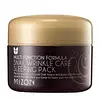What's inside
What's inside
 Key Ingredients
Key Ingredients

 Benefits
Benefits

 Concerns
Concerns

 Ingredients Side-by-side
Ingredients Side-by-side

Water
Skin ConditioningCentella Asiatica Extract
CleansingCaprylic/Capric Triglyceride
MaskingGlycerin
HumectantSqualane
EmollientSimmondsia Chinensis Seed Oil
EmollientCetearyl Alcohol
EmollientPotassium Cetyl Phosphate
EmulsifyingHelianthus Annuus Seed Oil
EmollientButylene Glycol
HumectantPolyglyceryl-3 Diisostearate
Emulsifying1,2-Hexanediol
Skin ConditioningMadecassoside
AntioxidantAsiaticoside
AntioxidantMadecassic Acid
Skin ConditioningAsiatic Acid
Skin ConditioningPanthenol
Skin ConditioningCeramide NP
Skin ConditioningSodium Hyaluronate
HumectantHydroxyacetophenone
AntioxidantSodium Carbomer
Emulsion StabilisingHydrogenated Lecithin
EmulsifyingHydroxyethylcellulose
Emulsion StabilisingCamellia Sinensis Leaf Extract
AntimicrobialWater, Centella Asiatica Extract, Caprylic/Capric Triglyceride, Glycerin, Squalane, Simmondsia Chinensis Seed Oil, Cetearyl Alcohol, Potassium Cetyl Phosphate, Helianthus Annuus Seed Oil, Butylene Glycol, Polyglyceryl-3 Diisostearate, 1,2-Hexanediol, Madecassoside, Asiaticoside, Madecassic Acid, Asiatic Acid, Panthenol, Ceramide NP, Sodium Hyaluronate, Hydroxyacetophenone, Sodium Carbomer, Hydrogenated Lecithin, Hydroxyethylcellulose, Camellia Sinensis Leaf Extract
Snail Secretion Filtrate
Skin ConditioningGlycerin
HumectantWater
Skin ConditioningCetyl Ethylhexanoate
EmollientButylene Glycol
HumectantDipropylene Glycol
HumectantCetearyl Alcohol
EmollientCyclopentasiloxane
EmollientCitrus Limon Peel Oil
MaskingOlea Europaea Fruit Oil
MaskingCitrus Aurantium Dulcis Oil
MaskingCitrus Aurantium Bergamia Fruit Oil
MaskingCedrus Atlantica Bark Oil
MaskingCitrus Aurantium Dulcis Fruit Extract
MaskingCitrus Grandis Fruit Extract
AstringentPinus Sylvestris Leaf Oil
MaskingLavandula Angustifolia Extract
Skin ConditioningSalvia Sclarea Oil
MaskingAniba Rosodora Wood Oil
AstringentEucalyptus Globulus Leaf Oil
PerfumingCitrus Aurantifolia Oil
CleansingCoriandrum Sativum Fruit Oil
MaskingSalvia Officinalis Oil
MaskingArtemisia Absinthium Extract
Skin ConditioningChamomilla Recutita Flower Extract
MaskingButyrospermum Parkii Butter
Skin ConditioningCaulerpa Lentillifera Extract
Sea Water
HumectantTremella Fuciformis Extract
HumectantSaccharomyces Ferment Filtrate
HumectantVanilla Planifolia Fruit Extract
Skin ConditioningSantalum Album Oil
MaskingHoney Extract
HumectantAureobasidium Pullulans Ferment
Skin ConditioningFomes Officinalis Extract
Skin ProtectingAcacia Seyal Gum Extract
HumectantGlycine Max Seed Extract
Skin ConditioningDioscorea Japonica Root Extract
Skin ConditioningGlyceryl Stearate
EmollientHydrogenated Polydecene
EmollientCyclohexasiloxane
EmollientSodium Polyacrylate
AbsorbentSorbitan Stearate
EmulsifyingPEG-100 Stearate
Magnesium Aluminum Silicate
AbsorbentPolysorbate 80
EmulsifyingCaprylyl Glycol
EmollientDimethicone
EmollientAminomethyl Propanol
BufferingAdenosine
Skin ConditioningPropylene Glycol
HumectantPentylene Glycol
Skin ConditioningEthyl Hexanediol
SolventGlyceryl Caprylate
Emollient1,2-Hexanediol
Skin ConditioningEthylhexylglycerin
Skin ConditioningSh-Octapeptide-4
AntioxidantSh-Decapeptide-7
AntioxidantSh-Pentapeptide-19
Skin ConditioningSh-Oligopeptide-9
HumectantCarbomer
Emulsion StabilisingXanthan Gum
EmulsifyingDisodium EDTA
Phenoxyethanol
PreservativePotassium Sorbate
PreservativeSnail Secretion Filtrate, Glycerin, Water, Cetyl Ethylhexanoate, Butylene Glycol, Dipropylene Glycol, Cetearyl Alcohol, Cyclopentasiloxane, Citrus Limon Peel Oil, Olea Europaea Fruit Oil, Citrus Aurantium Dulcis Oil, Citrus Aurantium Bergamia Fruit Oil, Cedrus Atlantica Bark Oil, Citrus Aurantium Dulcis Fruit Extract, Citrus Grandis Fruit Extract, Pinus Sylvestris Leaf Oil, Lavandula Angustifolia Extract, Salvia Sclarea Oil, Aniba Rosodora Wood Oil, Eucalyptus Globulus Leaf Oil, Citrus Aurantifolia Oil, Coriandrum Sativum Fruit Oil, Salvia Officinalis Oil, Artemisia Absinthium Extract, Chamomilla Recutita Flower Extract, Butyrospermum Parkii Butter, Caulerpa Lentillifera Extract, Sea Water, Tremella Fuciformis Extract, Saccharomyces Ferment Filtrate, Vanilla Planifolia Fruit Extract, Santalum Album Oil, Honey Extract, Aureobasidium Pullulans Ferment, Fomes Officinalis Extract, Acacia Seyal Gum Extract, Glycine Max Seed Extract, Dioscorea Japonica Root Extract, Glyceryl Stearate, Hydrogenated Polydecene, Cyclohexasiloxane, Sodium Polyacrylate, Sorbitan Stearate, PEG-100 Stearate, Magnesium Aluminum Silicate, Polysorbate 80, Caprylyl Glycol, Dimethicone, Aminomethyl Propanol, Adenosine, Propylene Glycol, Pentylene Glycol, Ethyl Hexanediol, Glyceryl Caprylate, 1,2-Hexanediol, Ethylhexylglycerin, Sh-Octapeptide-4, Sh-Decapeptide-7, Sh-Pentapeptide-19, Sh-Oligopeptide-9, Carbomer, Xanthan Gum, Disodium EDTA, Phenoxyethanol, Potassium Sorbate
 Reviews
Reviews

Ingredients Explained
These ingredients are found in both products.
Ingredients higher up in an ingredient list are typically present in a larger amount.
1,2-Hexanediol is a synthetic liquid and another multi-functional powerhouse.
It is a:
- Humectant, drawing moisture into the skin
- Emollient, helping to soften skin
- Solvent, dispersing and stabilizing formulas
- Preservative booster, enhancing the antimicrobial activity of other preservatives
Butylene Glycol (or BG) is used within cosmetic products for a few different reasons:
Overall, Butylene Glycol is a safe and well-rounded ingredient that works well with other ingredients.
Though this ingredient works well with most skin types, some people with sensitive skin may experience a reaction such as allergic rashes, closed comedones, or itchiness.
Learn more about Butylene GlycolCetearyl alcohol is a mixture of two fatty alcohols: cetyl alcohol and stearyl alcohol. It is mainly used as an emulsifier. Emulsifiers help prevent the separation of oils and products. Due to its composition, it can also be used to thicken a product or help create foam.
Cetearyl alcohol is an emollient. Emollients help soothe and hydrate the skin by trapping moisture.
Studies show Cetearyl alcohol is non-toxic and non-irritating. The FDA allows products labeled "alcohol-free" to have fatty alcohols.
This ingredient is usually derived from plant oils such as palm, vegetable, or coconut oils. There is debate on whether this ingredient will cause acne.
Due to the fatty acid base, this ingredient may not be Malassezia folliculitis safe.
Learn more about Cetearyl AlcoholGlycerin is already naturally found in your skin. It helps moisturize and protect your skin.
A study from 2016 found glycerin to be more effective as a humectant than AHAs and hyaluronic acid.
As a humectant, it helps the skin stay hydrated by pulling moisture to your skin. The low molecular weight of glycerin allows it to pull moisture into the deeper layers of your skin.
Hydrated skin improves your skin barrier; Your skin barrier helps protect against irritants and bacteria.
Glycerin has also been found to have antimicrobial and antiviral properties. Due to these properties, glycerin is often used in wound and burn treatments.
In cosmetics, glycerin is usually derived from plants such as soybean or palm. However, it can also be sourced from animals, such as tallow or animal fat.
This ingredient is organic, colorless, odorless, and non-toxic.
Glycerin is the name for this ingredient in American English. British English uses Glycerol/Glycerine.
Learn more about GlycerinWater. It's the most common cosmetic ingredient of all. You'll usually see it at the top of ingredient lists, meaning that it makes up the largest part of the product.
So why is it so popular? Water most often acts as a solvent - this means that it helps dissolve other ingredients into the formulation.
You'll also recognize water as that liquid we all need to stay alive. If you see this, drink a glass of water. Stay hydrated!
Learn more about Water